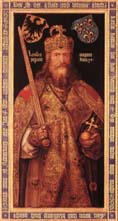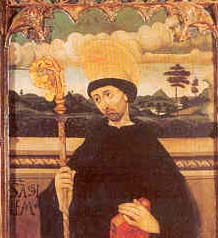Guilhem the short nosed (French Guillaume au Court Nez, or the Marquis au court nez); Guillaum de Narbonne; also Guillaume Fierabrace, Guillaume d'Orange, Guilhem de Gellone, Saint Guilhem.

![]() The
Languedoc, or rather its earlier incarnation Septimanie,
was occupied by Wisigoths
and then the Moors
before it was conquered by the Francs
at the beginning of the 8th century. This conquest was consummated
by the victory of Charles Martel at Poitiers in 732. For
the Francs this opened the way to the Mediterranean
Sea and the prospect of access to sea ports.
The
Languedoc, or rather its earlier incarnation Septimanie,
was occupied by Wisigoths
and then the Moors
before it was conquered by the Francs
at the beginning of the 8th century. This conquest was consummated
by the victory of Charles Martel at Poitiers in 732. For
the Francs this opened the way to the Mediterranean
Sea and the prospect of access to sea ports.
William a grandson of Charles Martel. He was born in France around the middle of the 8th century. His mother Aldana was a daughter of Charles Martel, so he was a cousin of Charlemagne. As a close kinsman of Charlemagne he spent his youth in the imperial court. William was made Count of Toulouse in 790, and Charlemagne placed his young son (Louis the Pious, who was to inherit Aquitaine), in his wardship. He was the second count of Toulouse and held the title from 790 until 811.
The name Gilhem is Occitan, corresponding to Latin, Guilhelmus, English William, French Guillaume.
Guilhem dedicated the next thirteen years to sustaining the southern frontiers of the Frankish empire. He was renowned as one of the most valiant warriors of his time. He subdued the Gascons, fought the Basques and resisted Moorish incursions. In 793 the Moorish ruler Hisham I, based in what is now Spain, proclaimed a holy war against the Franks to the north. He amassed an army of 100,000 men, half of whom attacked the Kingdom of Asturias while the other half attacked the Languedoc, penetrating as far as Narbonne. William engaged this army and defeated them at Orange. He engaged more Muslim forces near the river Orbieux, at Villedaigne, where this time he was defeated. The exhausted Muslim forces retreated to Spain (although they garrisoned and retained Narbonne). In 803 William played a part in the campaign that attacked Barcelona and won it from from the Moors. He know became Count of the Spanish Marches ('Marche d'Espagne').
He married twice, his second wife the Lady of Orange apparently the widow of a Saracen Lord that he killed and whose estates he seized. The widow was a beautiful woman called Gibourac (She had been called Orable, but having her christened gave him the opportiunity to change her name as well as her religion). They founded a new House of Orange - later to become one of Europe's leading royal houses (It once ruled England in the person of a later William of Orange and still rules in the Netherlands; it is remembered in the Orange Order in Northern Ireland, the orange stripe of the Irish Republican tricolour, and even the Orange Free State in South Africa.
Guilhem's exploits became famous and he evolved into the hero of medieval ballads of knightly prowess and chivalry. He is the hero of the Chanson de Guillaume, an early chanson de geste, and of several later sequels. This Epic of Guilhem of Orange (Guillaume d'Orange or William of Orange) was composed from the 11th to the 13th centuries, it is largely propaganda in which troubadours celebrate Guilhem at different times of his life. William's service to Charlemagne is portrayed as an idealised example of feudal loyalty. Some two dozen chansons de geste center upon William, including the 12th century epic La prise d'Orange giving a legendary treatment of the defeat of the Moors at Orange.

![]() This
period saw the flourishing of monasteries founded by powerful
franks - largely to help hold down their new empire and
stamp out Islam and Arianism - the latter an early form
of Christianity that the Catholic Church came to regard
as heretical. In 804 Guilhem retired to the Abbey of Aniane.
(For many centuries it was regarded as entirely laudible
for men to abandon their wives and families to become monks).
In 806 he headed a group of monks who set off to found the
Abbey
of Gellone (now Saint-Guilhem-le-Désert)
not far away near Lodève in the Diocese of Maguelonne.
He dedicated it to Saint Benedict of Aniane. In time a town
grew up around it, also called Saint-Guilhem-le-Désert,
now a well known tourist attraction.
This
period saw the flourishing of monasteries founded by powerful
franks - largely to help hold down their new empire and
stamp out Islam and Arianism - the latter an early form
of Christianity that the Catholic Church came to regard
as heretical. In 804 Guilhem retired to the Abbey of Aniane.
(For many centuries it was regarded as entirely laudible
for men to abandon their wives and families to become monks).
In 806 he headed a group of monks who set off to found the
Abbey
of Gellone (now Saint-Guilhem-le-Désert)
not far away near Lodève in the Diocese of Maguelonne.
He dedicated it to Saint Benedict of Aniane. In time a town
grew up around it, also called Saint-Guilhem-le-Désert,
now a well known tourist attraction.
Before his death, Charlemagne had given the young Guilhem a reliquary, which was believed to contained pieces of the True Cross. (Hundreds of such bogus relics were in circulation even before the Crusades). Guilhem left this one to his Abbey, where it remains to this day. The jewelled reliquary is carried through the village in procession once a year on the 3rd May - St Guilhem's feast day. Replicas made of biscuit are available in the Abbey Church. The faithful claim that they provide protection against lightening.
The Abbey was a major stop for pilgrims on their way to Santiago de Compostela. Pilgrims were attracted to Gellone because of the miracle working bogus relic - so many that Guilhem's corpse was exhumed from the narthex and given a more prominent home under the choir, to the annoyance of the Abbey of Aniane. As was normal in such circumstances, forged documents were produced by both sides to prove their claims.
The Sacramentary of Gellone is a famous manuscript dating to the late 8th century .
The Abbey's Romanesque cloister, abandoned and vandalised over many centuries found its way to The Cloisters in New York - or at least a large part of it did.
Guilhem is known by several different names, some of them reflecting his appearance, some his conquests, some his later religious life, and some merely confusion with other semi legendary Guilhems. He was Guilhem the short nosed (French Guillaume au Court Nez, or the Marquis au court nez); Guillaum de Narbonne; also Guillaume Fierabrace, Guillaume d'Orange, Guilhem de Gellone.
He was born in 755 and died on 28 May probably in 812. He was canonised in 1066, becoming Saint Guilhem.
According to the book Holy Blood Holy Grail Guilhem was the son of "Theodoric, king of the Jews of Septimania" crowned in 768. Through him the bloodline of Jesus bacame the bloodline of Frankish royalty. This fantasy was later incorporated into the plot of the bestselling novel The Da Vinci Code.






